Palm Springs shelter avoided COVID-19. Homeless say they need more than protection from virus
This story was produced as part of a larger project led by Nicole Hayden, a participant in the USC Center for Health Journalism's 2020 California Fellowship.
Her other stories in this project include:
Riverside County advocates want COVID-19 testing for homeless on the streets
Project Roomkey funding ends soon. Over 11,000 Californians could become homeless, again
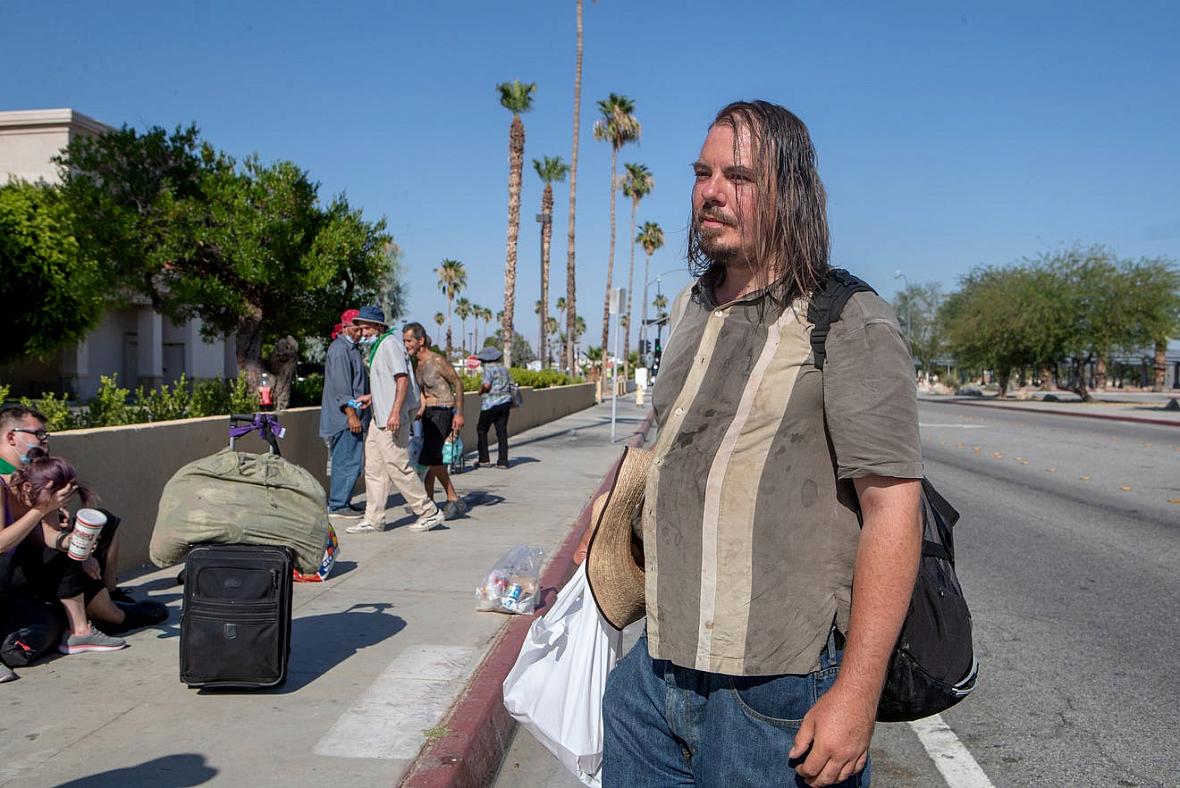
Janos Szilagyi, 39, right, waits across the street before the emergency overnight shelter run by the Coachella Valley Rescue Mission inside a portion of the Palm Springs High School Gymnasium on Saturday , June 27, 2020. Taya Gray, Taya Gray
Sammy Weakley arrived at the Palm Springs shelter two weeks ago, looking for a bottle of water and a place to rest his head.
But more than that, he hoped the shelter would open the door to other services, such as housing assistance and group therapy programs.
The 57-year-old man on Sunday night sat on one of the 50 beds sprawled across half of the Palm Springs High School gymnasium, where the shelter was moved at the start of the coronavirus pandemic. His life was piled up next to him — a backpack, some clothes and a cell phone charger.
Weakley was luckier than others. Just 15% of the western Coachella Valley’s nearly 320 homeless individuals got a bed that night. At least eight people were turned away before 7 p.m. — the shelter has been at capacity for three weeks now.
There is no other shelter within 22 miles.
Inside, residents say they have bigger fears than the coronavirus. A woman is seeking shelter from her spouse. A man is disabled. Another has been clean from addiction for 16 years. A mom who lost her job is there with her two kids.
Johnny Alvarez, 47, rests inside the emergency overnight shelter run by the Coachella Valley Rescue Mission inside a portion of the Palm Springs High School Gymnasium on Saturday , June 27, 2020. Taya Gray, Taya Gray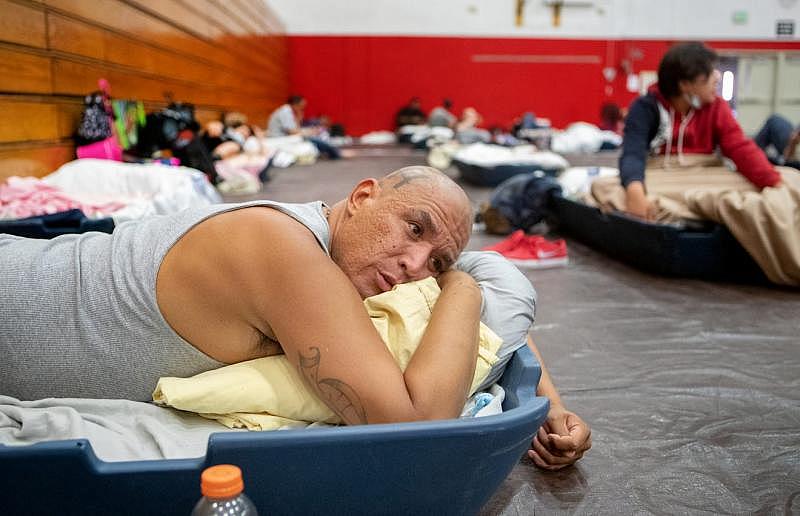
Many say the deep love of their God will continue to protect them throughout the pandemic because it has been their only salvation for far too long now.
Outside of the shelter, there are other matters they also feel are much more urgent: the threat of heatstroke, assault in their sleep, and a hunger for food.
Weakley said he is homeless because he struggles to stay sober and knows he can't stay clean without the right support.
“We need access to permanent housing services, but also we really need things like drug awareness classes and group programs,” Weakley said.
But in the week he's been at the shelter, Weakley said he hasn't been connected to social services yet.
As the pandemic rages on and temperatures regularly top triple digits, city and county officials are scrambling to provide resources for homeless individuals in the west Coachella Valley — but lack of funding and poor coordination are creating gaps. While accommodating social distancing in the shelter has allowed the community to avoid the virus, it also has led to fragmented services at multiple locations, a hardship for a population that often travels by foot.
Officials scramble to procure more shelters
Riverside County is working to secure two temporary overnight cooling centers in Cathedral City and Desert Hot Springs. This will create more room at the Palm Springs location, which has consistently served other cities' residents.
While the county is confident it has identified buildings for the cooling centers, it does not have the funding for those due to slim budgets and federal funding restrictions. Emergency cooling centers don't meet the qualifications needed to dip into certain funding pots meant for long-term, permanent solutions, said Greg Rodriguez, policy advisor for Riverside County Supervisor for the Fourth District V. Manuel Perez, who also leads collaborative homeless efforts in the Coachella Valley.
It would cost about $52,000 per month to fund this pair of shelters. While the county's homeless budget has mostly stayed consistent year to year, "the issue is, we don’t have county general fund money to access for these centers," Rodriguez said.
Johnny Alvarez, 47, secures a sheet to his mattress inside the emergency overnight shelter run by the Coachella Valley Rescue Mission inside a portion of the Palm Springs High School Gymnasium on Saturday , June 27, 2020. Taya Gray, Taya Gray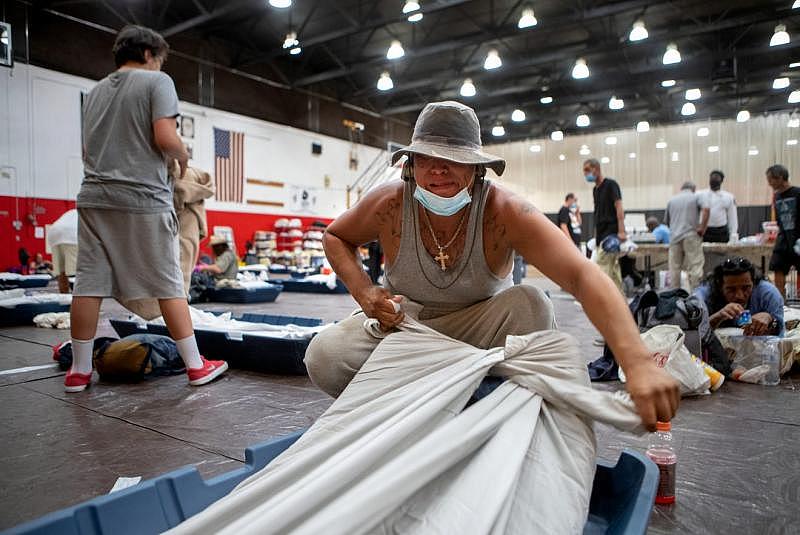
The county pleaded with the Desert Healthcare District last week to once again provide funding to launch the two additional summer shelters, which the district did last year under a last-minute rush to beat the heat. The district board advised Rodriguez to submit a formal request for funds to be considered.
It's a resource, the shelter clients say, that should be available year-round.
“If we can find a permanent, 24/7 place then we could add things that people really need like group programs,” said Palm Springs shelter leader Arnold Giles.
These temporary centers are meant to be a Band-aid for the larger problem of homelessness and housing. Every summer, officials are hopeful that by next year there will be something more permanent in the western Coachella Valley — to no avail.
Rodriguez does have plans to push for using federal CARES Act dollars to fund a permanent facility in Palm Springs that could potentially encompass an emergency shelter, affordable housing units and other supportive services.
But those funds cannot be used to keep the temporary Palm Springs shelter open indefinitely, nor can they be used to open additional temporary locations. The Palm Springs facility's operations are paid for through September — Riverside County pays the Coachella Valley Rescue Mission around $38,000 a month to manage it — but after that, homeless individuals in the western Coachella Valley will be without a place to sleep.
While the city of Palm Springs plans to use a one-time $10 million allocation from the state to build affordable housing, Palm Springs Mayor Pro Tem Christy Holstege said she hopes that the county will fund a project that provides emergency transitional beds — both resources are needed to address homelessness. The city, too, faces a budget deficit due to the pandemic.
“The mayor and I sent a letter to the county during their budget setting asking that they fully fund homeless services in Palm Springs and the valley," Holstege said. "We have continued to subsidize a lot of those services, but now that we are facing a budget deficit, this operation needs to be on the county.”
Shelter 'can't let more people in' due to social distancing protocols
The biggest dilemma at the Palm Springs shelter is not what officials thought it would be: No residents or staff have tested positive for coronavirus.
The lack of coronavirus cases in the shelter is a bit confounding, based on the sheer number of positive cases confirmed among the general population. One explanation might be that the insular community has mostly not crossed paths with the world’s travelers or the valley’s essential workforce or the bar-goers who jumped at the chance to momentarily sip $18 cocktails again.
To combat a potential spread, there are constant temperature checks at the shelter, with the intention of turning people away who display COVID-19 symptoms. The shelter also offers hand sanitizer and face masks that folks sometimes wear but mostly don’t.
Johnny Alvarez, 47, center, motions to his mother upon checking into the emergency overnight shelter run by the Coachella Valley Rescue Mission inside a portion of the Palm Springs High School Gymnasium on Saturday , June 27, 2020. Taya Gray, Taya Gray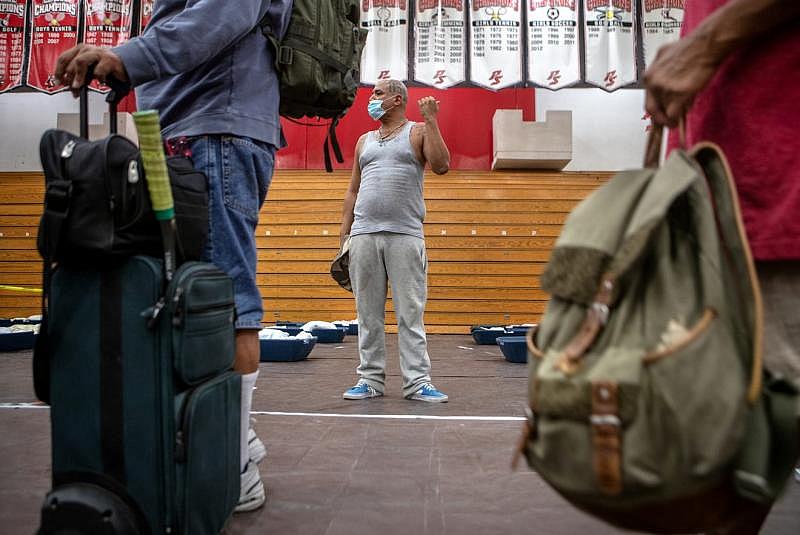
Homeless communities across the state have not been this lucky. Coronavirus has continued to spread through encampments and shelters in Los Angeles County and the Bay Area, compounded by the fact that homeless individuals often lack access to health care and have chronic conditions that can make COVID-19 symptoms worse.
The challenge in Palm Springs was finding a large enough building to accommodate a significant number of people with 6 feet between each sleeping body in hopes of preventing an outbreak, Rodriguez said.
The shelter moved into Palm Springs High School at the start of the pandemic, which allowed for 6 feet of space between each bed. Previously, the shelter found home at the former Boxing Club across from the Palm Springs Airport, where 50 people slept just inches apart.
Now, the facility must move once again so the school can reconfigure the building to create classrooms with enough space between students come fall. The shelter will move to its next temporary location, Palm Springs United Methodist Church, this weekend.
Giles said he would ideally like to accommodate 25 more beds — for a total of 75 people — so he can stop turning people away, even though half of the gymnasium has remained empty.
Coachella Valley Rescue Mission employee Charles Dangerfield the third closes the door to the portable shower used by guest staying at the emergency overnight shelter run by the Coachella Valley Rescue Mission inside a portion of the Palm Springs High School Gymnasium on Saturday , June 27, 2020. Taya Gray, Taya Gray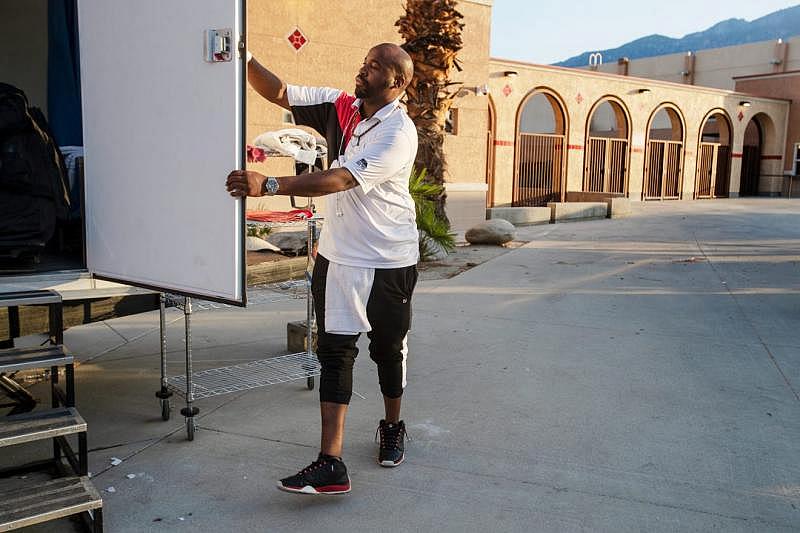
“When there are no beds here, I don’t know where people go, there’s no place else to send them,” he said. “But because of social distancing ... we can’t let more people in.”
Rodriguez said only half of the gymnasium was used because there wasn't a demand for more space — the Coachella Valley Rescue Mission, he said, never informed him that they had to turn people away.
Giles also hopes to have handicap-accessible bathrooms, showers and a kitchen. Because the high school would not allow the mission to use the building’s bathrooms and showers, the shelter had to bring in portable units.
While the portable toilets are larger, handicap accessible units, they still aren’t very accessible. A wheelchair-bound woman on Sunday wheeled forward into a unit, but then couldn’t turn her wheelchair around in the tight space to let herself out. She banged on the door until someone opened it for her.
Janos Szilagyi, 39, whose right arm is mostly paralyzed and whose hand is permanently clenched in a fist, said it is hard to unbutton his pants in the small space with no light.
Janos Szilagyi, 39, center sits on his mattress inside the emergency overnight shelter run by the Coachella Valley Rescue Mission inside a portion of the Palm Springs High School Gymnasium on Saturday , June 27, 2020. Taya Gray, Taya Gray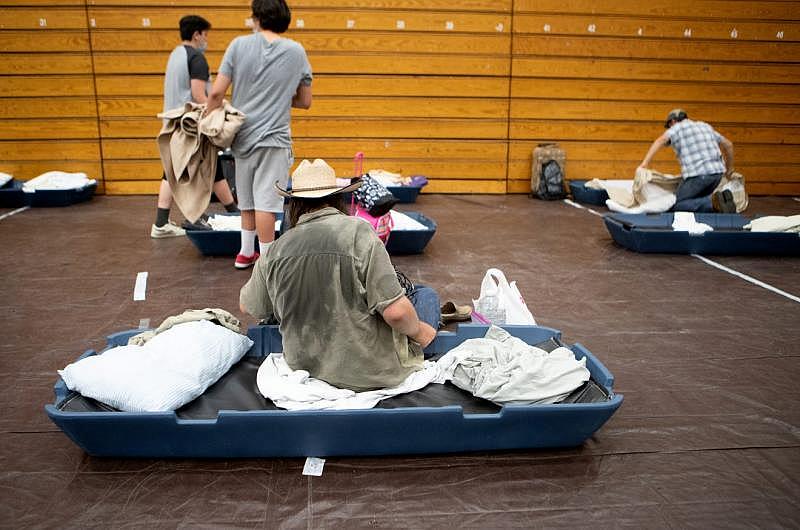
Additionally, Martin Martinez, 57, said wheelchair-bound clients can’t use the showers, which require people to walk up a few steps to access the stalls. He said he recently watched a woman try to crawl up the stairs and into the shower.
Being wheelchair-bound also means it can be challenging to make it across town to The Well in the Desert, a daytime resource and cooling center in Palm Springs, which has handicap-accessible showers available during the day.
Officials at the Coachella Valley Rescue Mission declined to answer questions about shelter concerns from The Desert Sun. Spokesperson Scott Wolf said they were busy with the transition to the new space and would "be happy to answer all concerns and comments once we have made the smoothest transition."
Fragmented resources lead to confusion
Melissa Cogar, 40, her husband and kids have been homeless for about a year but have been staying at the Palm Springs shelter for a week since relocating from San Diego. They were hoping when they arrived that they would be connected to a case worker, directed toward an access center or at least given a list of phone numbers for housing and job services. That did not happen, Cogar said.
“We are willing to put in the work, we just don’t know where to start,” she said.
Shelter clients say it would be helpful if newcomers were handed a list of local resources when they signed in for the first time. While staff is present to make sure they have access to beds, linens and water, and to make sure the facility remains safe, there aren't consistent staff providing information about social service resources.
Johnny Alvarez, 47, center, walks toward the emergency overnight shelter run by the Coachella Valley Rescue Mission inside a portion of the Palm Springs High School Gymnasium on Saturday , June 27, 2020. Taya Gray, Taya Gray
Before the shelter opens for the night, people can seek reprieve from the heat at The Well in the Desert, which offers supportive services. As of two weeks ago, the Well expanded summer hours to 7:30 a.m. to 6 p.m. — typically doors close at 3 p.m.
Individuals also can seek services at the access center run by the Coachella Valley Association of Governments and Path of Life housing at the former Boxing Club across from the Palm Springs Airport. The center provides housing and behavioral health services, among other resources, from 8 a.m. to 7 p.m.
However, at least seven people who had been staying at the overnight shelter for the past week didn't know the access center nor the Well existed. Before the pandemic, the access center used the Boxing Club during the day and the mission used it for the shelter at night, making it easy for individuals to receive a variety of services in one place.
There has been additional confusion among residents about the shelter's hours of operation.
People place clean sheets on their mattress inside the emergency overnight shelter run by the Coachella Valley Rescue Mission inside a portion of the Palm Springs High School Gymnasium on Saturday , June 27, 2020. Taya Gray, Taya Gray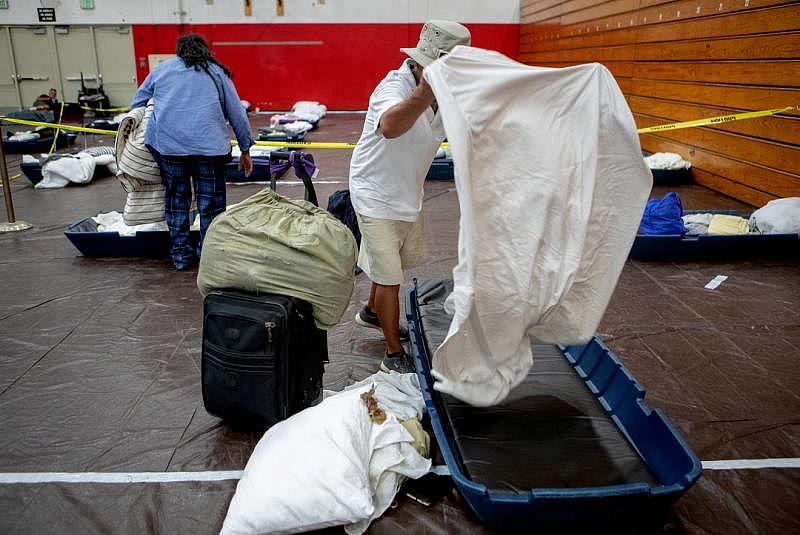
While city and county officials announced on Palm Springs' website and through an informative flyer that the overnight shelter would be open from 3 p.m. to 7 a.m. each day, the doors actually open at 5 p.m.
If people line up too early, they are told they must go elsewhere. Some walk across the street to seek shade on the Palm Springs Cultural Center property until staff tell them they must leave. If they “loiter” at either property, they are banned from the shelter for the night and must find somewhere else to sleep.
If they get there too late, the shelter will be full.
Holstege said the city of Palm Springs has made requests to both the county and Coachella Valley Rescue Mission to address these issues.
“City council repeatedly asked the county make the shelter 24/7, though funding continues to be an issue,” Holstege said. “The city did hear about people loitering and not being able to enter the shelter, and we asked CVRM to resolve that.”
Rodriguez says the county hopes to expand staffing in order to open earlier.
Pandemic results in cuts to resources
There's not much to do at the gymnasium once clients arrive. There's no television or computers. Education at the shelter can sometimes look like a young man in his 20s teaching a couple teens how to rap.
"They tried to clean the Salton Sea, but it still made us sick," he sings.
Clients want more than that.
While most shelter clients were already resting on their cots for the night by 6:30 p.m. and plugging in their cell phones to charge for the first time all day, Joaquin Jimenez, 47, wanted to step outside to catch some of the last quiet moments before the sun set.
Coachella Valley Rescue Mission employee Charles Dangerfield the third, right, checks in a guest to the emergency overnight shelter run by the Coachella Valley Rescue Mission inside a portion of the Palm Springs High School Gymnasium on Saturday , June 27, 2020. Taya Gray, Taya Gray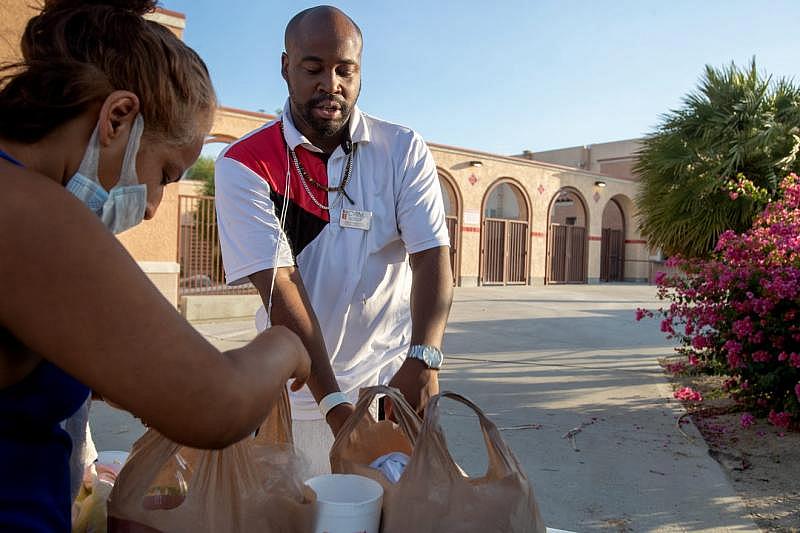
“People here, they really need mental health help,” he said. “It is really hard when people just say you are crazy or broken. My whole life I didn’t know I had a mental health disorder, but I do now. But even still, I know I am courageous and smart. I know I am not stupid, but sometimes that is how they treat you.”
Just a few feet from Jimenez, Martinez walked loops around the property, talking about solutions to the world’s problems with anyone who would listen. Like many others at the shelter, he is upset by how staff work with individuals with mental health issues.
“We don’t have people here who are properly trained to know how to deal with mental health things,” he said. “They are kicking mental health patients out in the middle of the night here because they are having an episode, and no one here knows how to talk to them or calm them down."
At the prior Boxing Club location, behavioral health specialists employed by the city of Palm Springs walked through the shelter multiple times a week to address people’s needs, from housing to mental health.
Under an agreement with the Desert Healthcare District, two of those workers were funded by Palm Springs and two were funded by the healthcare district.
However, due to the city’s pandemic-induced budget woes, Palm Springs pulled funding for two of the workers. The two funded by the healthcare district are still active.
Janos Szilagyi, 39, right, waits across the street before the emergency overnight shelter run by the Coachella Valley Rescue Mission inside a portion of the Palm Springs High School Gymnasium on Saturday , June 27, 2020. Taya Gray, Taya Gray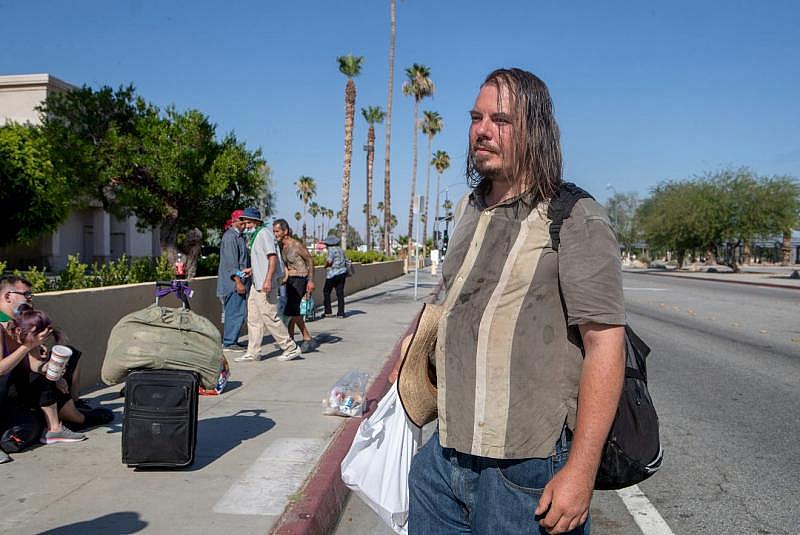
The city plans to ask the Desert Healthcare District to continue to fund the other two outreach workers, Palm Springs Mayor Geoff Kors said. The district would need to review this request during a formal board meeting.
On recent Sunday, Szilagyi asked anyone who walked by if they could give him the phone number of a housing caseworker or a behavioral health specialist.
He just wanted to know what the first step to securing housing was — he thought coming to the shelter would provide a way forward.
Desert Sun reporter Nicole Hayden covers health in the Coachella Valley. She can be reached at Nicole.Hayden@desertsun.com or (760) 778-4623. Follow her on Twitter @Nicole_A_Hayden.
This article was produced as a project for the USC Annenberg Center for Health Journalism’s 2020 California Fellowship.
[This story was originally published by Desert Sun].

